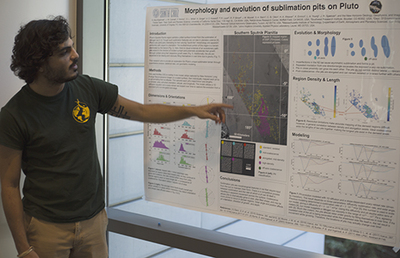Matching gift will boost funds—and opportunities—for undergraduates doing research
Hierarchical Systems Research Foundation (HSRF) is asking you to donate towards changing young scientists’ lives while increasing the breadth of human knowledge. The foundation—which has long been a generous donor to UC Santa Cruz—is offering to match donations of all sizes to the newly formed Endowment for Undergraduate Research in Science and Technology.
Hands-on scientific research is usually reserved for graduate students and faculty, but at UC Santa Cruz ambitious undergraduate students can join a faculty member’s lab or even do independent research.
Experiences pursuing science alongside faculty have inspired numerous students to go on to scientific careers. HSRF founder David Doshay (B.A. ‘83, physics; M.S. ‘90) says his own experience at UC Santa Cruz was transformative.
Building human knowledge
“You put everything you have learned into figuring out a question when nobody knows the answer,” he says. “It is very different from being a student in a class solving homework problems.”
When he was an undergraduate, Doshay took a teaching assistant up on an offer to continue another student’s research. He found himself working in a lab pioneering the branch of science known as Chaos Theory. In addition to working on his own on an experiment in fluid turbulence, he gave a lecture on Chaos Theory at the annual meeting of the American Physical Society and attended conferences where he was able to discuss his work with other scientists.
“You’re not first and foremost an undergrad, you’re someone who has a unique piece of research to share,” he says. “That changed everything for me.”
Bringing original science within reach

Since Hierarchical Systems Research Foundation began supporting students at UC Santa Cruz in 2004, it has assisted close to 130 undergraduate and graduate students. The research grants provide resources for laboratory fees, equipment, and expenses related to preparing conference presentations—expenses that could put a project out of reach for many students. The grant application can also ask for living expenses to free awardees from the need to find employment unrelated to a career in science.
HSRF scholar Anikeya Aditya’s ongoing research focuses on the possibility that the universe’s dark matter formed in black holes shortly after the Big Bang. For Aditya (Crown ‘18, math/physics) the grant validates his pursuit of research as an undergraduate.
“It is a great source of motivation as I feel rewarded for working in academic research,” he says.
Nadim Abu-Hashmeh (Oakes ‘17, Earth sciences) worked with images collected from Pluto in 2015 by the New Horizons space probe. Through computer modeling, Abu-Hashmeh concluded that pits in the icy surface probably had traveled over time. His grant will enable him to present his results at an upcoming meeting of the American Geophysical Union.
“Especially since this is new research,” he says, “I wanted to be able to communicate this with other researchers in the field who are doing the same things I am.”
The wisdom of the crowd
By offering a matching gift, HSRF hopes to encourage everyone—each to their own ability—to join in supporting these life-changing opportunities. For first-time donors, the match will be 2:1. HSRF will also triple first-time donations established as monthly installments.
“Small donations add up. They do make a difference,” Doshay says. “It’s not the amount. It’s that you do it that counts. While many people think of philanthropy as only for the very rich, I believe that it is more of an attitude of helping to improve the world and doing it on a scale that is appropriate for one’s personal circumstances. HSRF’s match is a way to multiply the efforts of small donors and help them feel that their donations add up to something of consequence.”
This generous match is one of the featured fundraisers in UC Santa Cruz’s fall crowdfunding campaign, Fall into Philanthropy, capitalizing on the power of the “crowd” to make rapid progress toward major goals.